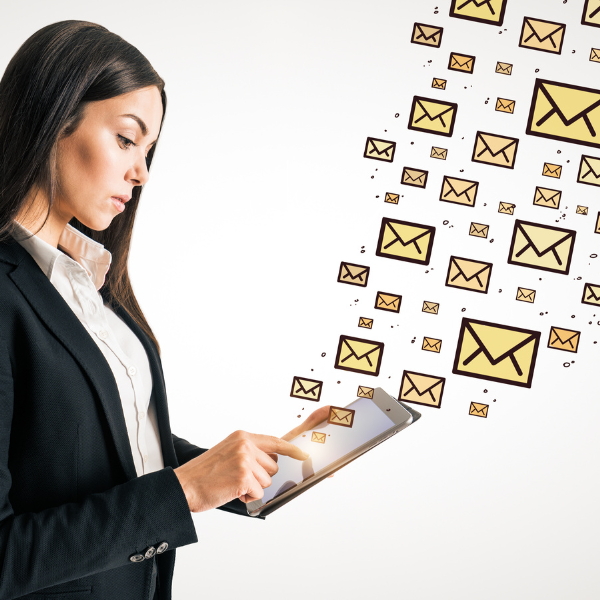
The new year offers small business marketers fresh opportunities to help boost company growth through strategic email marketing campaigns. By creating compelling content to engage both new contacts and current email subscribers, brands can showcase offerings, highlight deals, and drive sales during the pivotal first business quarter.
Email still proves to be one of the highest-converting marketing channels. Implementing a targeted email strategy can spark business growth, whether you send monthly newsletters, run promotions, or demonstrate your brand value.
This guide looks at 10 email marketing strategies to help small businesses continue momentum beyond a successful holiday sales season.
Top Email Marketing Strategies for Small Businesses
Offer New Year Promotions and Sales
Capitalize on anticipation for post-holiday sales with limited-time discounts or special New Year bundles. Incorporate free shipping or gift incentives too. New Year promotions remind subscribers of your brand after holiday distractions subside.
Send a sequence of deal emails, as subscribers expect discounts soon after holidays end. Don’t leave it too late.
Summarize Past Year Accomplishments
Reconnect post-holidays by sending a year-in-review email newsletter. Highlight major company, product, and team accomplishments from the last 12 months. Recapping milestones like a website revamp or new product line lets subscribers relive the journey. Thank them for their support and preview what’s ahead.
Review emails show how you delivered value for customers last year. This reminds subscribers why they should consider supporting your brand in the future.
Set Goals with Subscriber Input
Use interactive email surveys around the new year to engage subscribers in upcoming plans. Ask them directly what types of products, services, or experiences they would find most valuable from your business in the coming year. This allows subscribers to guide your brand’s future direction. Ask questions like:
Let participants know you take their responses seriously in shaping future plans. They will pay more attention, knowing their responses directly impact what you provide going forward.
Improve Email Capture Forms
The new year is an ideal time to overhaul opt-in forms or email sign-up processes across your company’s touchpoints. Offering limited-time promotions after the holidays can entice subscribers to provide updated preferences and contact data again.
Take a look at what’s currently motivating visitors to convert and sign up for emails. Identify specific ways to build on those effective lead generation techniques. For example, emphasize exclusive access to special content subscribers gain by joining your list. Also ensure the opt-in process stands out clearly across all sites so opportunities aren’t missed due to lack of visibility or user distrust.
Make sure any data collection continues following the most up-to-date privacy rules. Your ideal email subscribers need to be compliant contacts who genuinely want to hear from you.
Update Design and Branding
The new year is a chance to evaluate if branding and design elements aptly reflect your current business identity and style. Review website images, email templates, logos, and color schemes. Do they resonate with who you are today? Updating visual assets demonstrates your brand stays fresh and current. And since most people access emails via mobile now, make responsive, optimized design across devices a priority too.
Segment Subscriber Lists
Personalize outreach by segmenting your subscriber list based on behaviors and attributes indicating their interests. For example, group together buyers who purchased certain products, attended past events, or click on video links frequently. Then customize emails to align with each group’s preferences for greater relevance and engagement.
Laser-focused messages demonstrate your brand understands subscribers’ needs, and your audience will pay more attention to content speaking directly to them. Relevant segmentation also reduces unsubscribes.
Automate More Customer Touchpoints
The set-it-and-forget approach of email automation frees small teams to handle other priorities throughout the year. But automated messages can still feel personalized when triggered by subscriber behaviors.
For example, send an automatic welcome series introducing new contacts to your offerings over a preset time frame. Or follow up speedily when tracking abandoned online carts.
Lifecycle emails activated by subscriber milestones work too, like thanking repeat customers as purchase totals hit preset thresholds. Identify additional scenarios where timely, relevant auto-messages could engage subscribers in the coming year.
Improve Email Deliverability and Tracking
With new budgets approved, small businesses should review email providers and systems. Ensure you have security protocols and compliance measures to minimize the risk of vital messages being blocked or sent to spam. Don’t forget to track engagement too. Monitoring open and click-through rates shows what content resonates most with subscribers.
Prioritize Value and Storytelling
Rather than aggressive sales pitches, use storytelling to address customer challenges, explaining how you can uniquely help subscribers.
For example, share a relatable story about a customer finally getting organized thanks to your storage solutions. Or showcase how a local shop owner expanded their bakery with help from your reliable payment product.
Use compelling stories to show how you understand subscribers’ needs; let creative narratives demonstrate the value and purpose of your business.
Continually Test and Optimize
Effective email marketers continually test and refine messages, measuring engagement over time. Take inspiration from the most clicked or shared emails of the past year and expand on those themes with fresh content.
Don’t overlook small details either. Try new subject lines, short content, or alternative send times. Then measure engagement rates and double down on what data shows subscribers truly want from your emails.
Learn From Past Successes
Use email insights from last year to shape plans for the year ahead. What content and approaches got subscribers to engage more with your messages? What led to disengagement?
Paying attention to what resonated well lets you craft email campaigns that align with your small business goals. Email success starts with building on past strengths while keeping goals for the coming months in focus.

